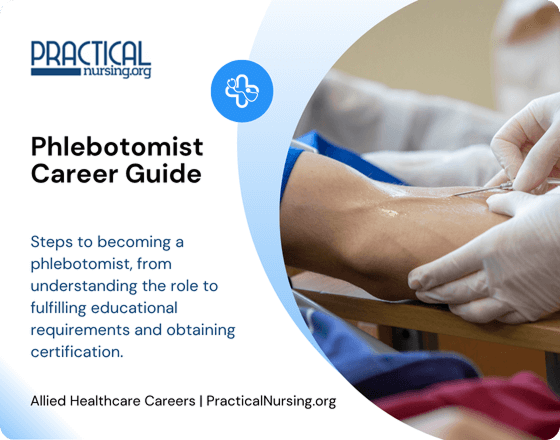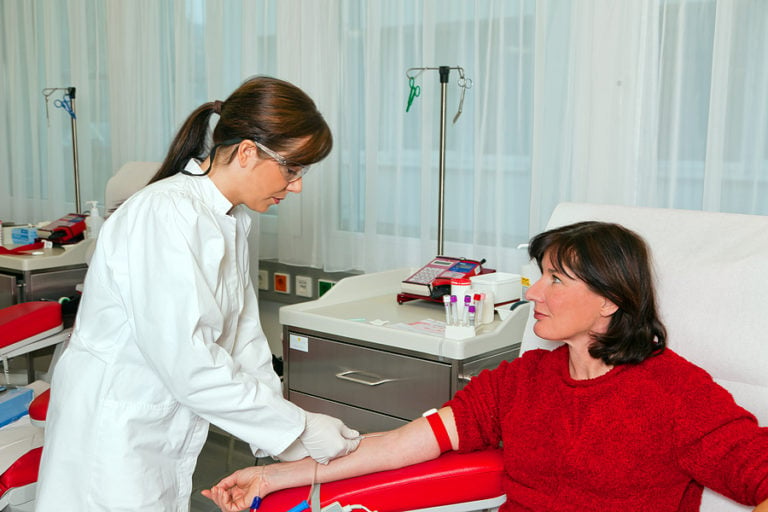How to Become a Phlebotomist
Becoming a phlebotomist is a rewarding career choice for individuals interested in the healthcare field. Phlebotomists play a crucial role in the medical industry by collecting blood samples for diagnostic testing, blood donations, and research purposes.

Written by Jane Dewy and Edited by The PracticalNursing.org Editorial Team.


Becoming a phlebotomist is a rewarding career choice for individuals interested in the healthcare field. Phlebotomists play a crucial role in the medical industry by collecting blood samples for diagnostic testing, blood donations, and research purposes. Perhaps you are a student considering an entry-level healthcare role and want to compare phlebotomy to licensed practical/vocational nursing. The following will guide you through the essential steps to becoming a phlebotomist, from understanding the role to fulfilling educational requirements and obtaining certification.
Step 1: Understand the Role of a Phlebotomist
Before embarking on the journey to become a phlebotomist, it is crucial to have a clear understanding of the role. Phlebotomists are responsible for drawing blood from patients, labeling and storing samples, and ensuring accurate documentation. They work closely with healthcare professionals to contribute to accurate diagnoses and treatment plans. Additionally, phlebotomists must possess strong communication skills, empathy, and attention to detail to create a positive patient experience.
Phlebotomist vs LPN
Distinguishing between the roles of a phlebotomist and an LPN is essential for those aspiring to contribute to the well-being of others. In this context, understanding the differences between phlebotomists and licensed practical nurses (LPNs) is paramount. Despite both professions involving patient care, they operate in unique healthcare settings and cater to different aspects of overall health.
Phlebotomists primarily focus on:
- Blood collection and specimen handling
- Patient interaction
- Lab assistance
- Infection control
- Record keeping
Licensed Practical Nurses (LPNs) primarily focus on:
- Comprehensive patient care
- Wound care and procedures
- Patient advocacy
- Collaboration in care plans
- Health education
Step 2: Fulfill the Educational Requirements of a Phlebotomist
While the educational requirements for phlebotomists may vary by state, most employers prefer candidates with formal training. Many community colleges, technical schools, and vocational institutions offer phlebotomy programs. These programs typically cover topics such as anatomy, physiology, medical terminology, and practical phlebotomy skills.
During the educational phase, aspiring phlebotomists gain hands-on experience in drawing blood, understanding venipuncture techniques, and practicing proper specimen handling. Some programs also include clinical rotations in healthcare settings to provide real-world exposure.
Certification
While certification is not always mandatory, obtaining certification can significantly enhance your employment prospects and validate your skills. The most widely recognized certification for phlebotomists is offered by organizations such as the National Phlebotomy Association (NPA), the American Society for Clinical Pathology (ASCP), and the National Healthcareer Association (NHA). These certifications typically require candidates to pass an exam that assesses their theoretical knowledge and practical skills.
Employers often prefer certified phlebotomists due to the assurance of a standardized level of competence. Certification may also lead to higher earning potential and increased job opportunities.
Step 3: Apply For Phlebotomist Jobs
Once you have completed your education and obtained certification, it’s time to start applying for phlebotomist positions. Job opportunities for phlebotomists can be found in hospitals, clinics, laboratories, blood donation centers, and other healthcare settings. Create a compelling resume that highlights your education, certification, and any relevant experience or internships.
During the application and interview process, emphasize your communication skills, attention to detail, and commitment to patient care. Phlebotomy is a customer-focused role, and employers seek candidates who can make patients feel comfortable and at ease during the blood collection process.
More Allied Healthcare Careers
Discover more allied healthcare career guides and resources for practical nursing professionals and students to understand the available opportunities.
Provide hands-on care and daily support to patients in hospitals, nursing homes, and long-term care facilities. Learn how to become a CNA and start your healthcare career quickly. Explore CNA programs and career paths.
Play a key role in clinics and physicians’ offices by handling both administrative and clinical tasks. Medical assisting offers fast entry into healthcare with strong job growth. Learn how to become a medical assistant.
Assist dentists during procedures, manage patient care, and keep dental offices running smoothly. This in-demand role offers fast-track training and career stability. Get started as a dental assistant today.
Support pharmacists in preparing medications, managing prescriptions, and helping patients. A pharmacy tech role offers structure, growth, and entry into the pharmaceutical field. Discover how to become a pharmacy technician.
Related Articles
- LPN/LVN Program Admissions: What Schools Are Really Looking For
- LPN’s in Teaching Roles
- Public Health Nursing Careers with BSN
- Can I Become an LPN If I Have a Criminal Record?
- Pokémon GO! A Nurse’s Viewpoint
- Top States for LPN/LVNs: Where to Thrive in Your Practical Nursing Career in 2025
- LPN Training & Financial Aid for Veterans and Military Service Members
- LPN Programs Online